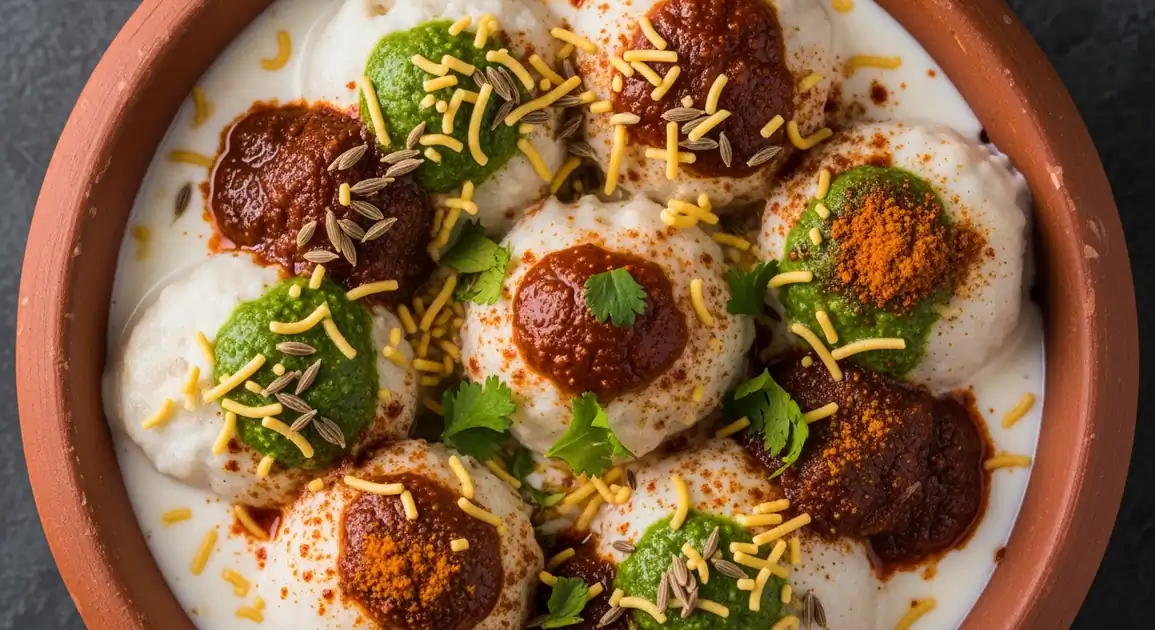Dahi Vada (Yogurt-Soaked Lentil Dumplings)
दही वड़ा (Dahi Vada)

Description
Dahi Vada is a beloved North Indian snack found across India in various regional adaptations. In the north, it's commonly known as Dahi Bhalla or Dahi Vada, while southern versions appear as Thayir Vadai or Mosaru Vada. The dish is particularly popular during festive seasons and hot weather months, where its cooling yogurt base provides welcome refreshment.
Dietary Information
Serving information
Serving style
Typically served in disposable bowls, small clay pots (kulhads), or pressed leaf plates (dona/pattal). Eaten with a spoon, often immediately after preparation with the various chutneys and spices layered on top.
Quick facts
Most chaat vendors operate from around 11 AM - 9 PM, with peak hours in the evening from 4 PM - 8 PM.
Safety Tips
What to Look For
-
Fresh, creamy yogurt without separation or excessive sourness
The yogurt should look fresh, white, and homogeneous without signs of curdling or separation. Properly stored yogurt is crucial as it's the primary component.
-
Vadas kept separate from yogurt until serving time
Quality vendors keep the fried vadas separate and only assemble the dish when ordered, preventing them from becoming overly soggy.
-
Clean, covered containers for yogurt and chutneys
Proper storage of dairy and chutneys prevents contamination and spoilage, especially in hot weather.
-
Refrigeration or cooling system for yogurt storage
Especially important in warm weather, proper temperature control for dairy products reduces bacterial growth.
-
Fresh, vibrant-colored chutneys
The mint-coriander chutney should be bright green and the tamarind chutney should be reddish-brown, indicating freshness.
What to avoid
-
Yogurt with strong sour smell or yellowish color
These are signs the yogurt has spoiled or been left unrefrigerated too long, which can cause stomach issues.
-
Pre-assembled dahi vadas sitting out for extended periods
Once assembled, the dish should be consumed promptly, not left sitting in heat where bacteria can multiply.
-
Flies or insects around the serving area
Indicates poor hygiene practices and increases contamination risk.
-
Dirty serving utensils or containers
Can introduce harmful bacteria to otherwise safe food.
-
Vendors who handle money and food without washing hands or changing gloves
Cross-contamination risk increases when proper handling practices aren't followed.
Price information
Price range
Budget tips
- Street vendors and small chaat stalls typically offer the most affordable options (30-60 INR).
- Sweet shops (mithai walas) charge slightly more (50-80 INR) but often provide better quality.
- Restaurant versions can cost 80-120 INR but usually come with more elaborate presentations and sides.
- Avoid tourist-focused vendors who may charge inflated prices for the same quality.
Value indicators
- Generous yogurt coverage without being too watery
- Soft, well-soaked vadas that still maintain some structure
- Fresh, vibrant chutneys (not dull in color)
- Balanced flavor profile with distinct sweet, sour, and spicy notes
- Proper garnishing with spices and possibly sev or coriander leaves
Where to Find This Dish
Market Areas
Found in almost every major market throughout India.
Local bazaars, Shopping districts
Evening, Weekend afternoons
Temple Vicinities
Many chaat vendors set up near popular temples to cater to devotees.
Temple entrance areas, Surrounding streets
Morning, Evening
Street Food Hubs
Areas known for their concentration of street food vendors.
Designated street food zones, Food streets
Evening, Night
Vendor Tips
- Follow locals - they know which vendors maintain quality and hygiene.
- Look for vendors who make their chutneys fresh daily rather than using bottled versions.
- Some vendors allow customization of spice levels - don't hesitate to ask.
How to Order
Regional Variations
-
Delhi-style Dahi Bhalla
(दिल्ली वाले दही भल्ले)
Distinguished by extra-soft vadas that are soaked longer in water before being dressed with yogurt. Typically includes both sweet and spicy chutneys and a generous sprinkle of crushed crunchy sev on top.
-
Punjabi Dahi Vada
(पंजाबी दही वड़ा)
Often made with a combination of urad and moong dal, slightly firmer in texture, and generously topped with yogurt that's seasoned with roasted cumin and black salt.
-
Raj Kachori Dahi Vada
(राज कचौरी दही वड़ा)
An elaborate version where the vadas are served inside a large crispy kachori (hollow fried pastry) along with yogurt, chutneys, spiced mashed potatoes, and multiple garnishes.
-
Thayir Vadai
(தயிர் வடை)
The South Indian variation, typically using a different lentil mix for the vadas and yogurt that's often tempered with mustard seeds, curry leaves, and asafoetida.
-
Dahi Vada with Aloo Dum
(आलू दम के साथ दही वड़ा)
A variation where the dahi vada is served alongside spiced potato curry, creating a more substantial dish that combines both flavors.
Cultural context
History
Dahi Vada has ancient roots in Indian cuisine, with variations found in texts dating back several centuries. It originated in North India, likely in present-day Uttar Pradesh or Delhi region, and has evolved into regional variations like Dahi Bhalla (Delhi style), Dahi Bara (Odisha), and Thayir Vadai (South India). Originally a festive dish prepared during celebrations, it transitioned to becoming a popular street food during the 20th century. In Delhi, it gained particular prominence as 'Dahi Bhalla' and became an iconic part of the city's chaat culture.
Local significance
Dahi Vada represents the Indian culinary art of balancing contrasting flavors and textures in a single dish. It's an essential part of chaat culture and often features in celebrations and casual social gatherings.
Eating customs
- In North India, it's common to eat it alongside other chaat items like gol gappas or papri chaat.
- Often enjoyed with a beverage like jaljeera or masala chaas (spiced buttermilk).
- Typically eaten in the afternoon or evening as a snack rather than as part of a main meal.